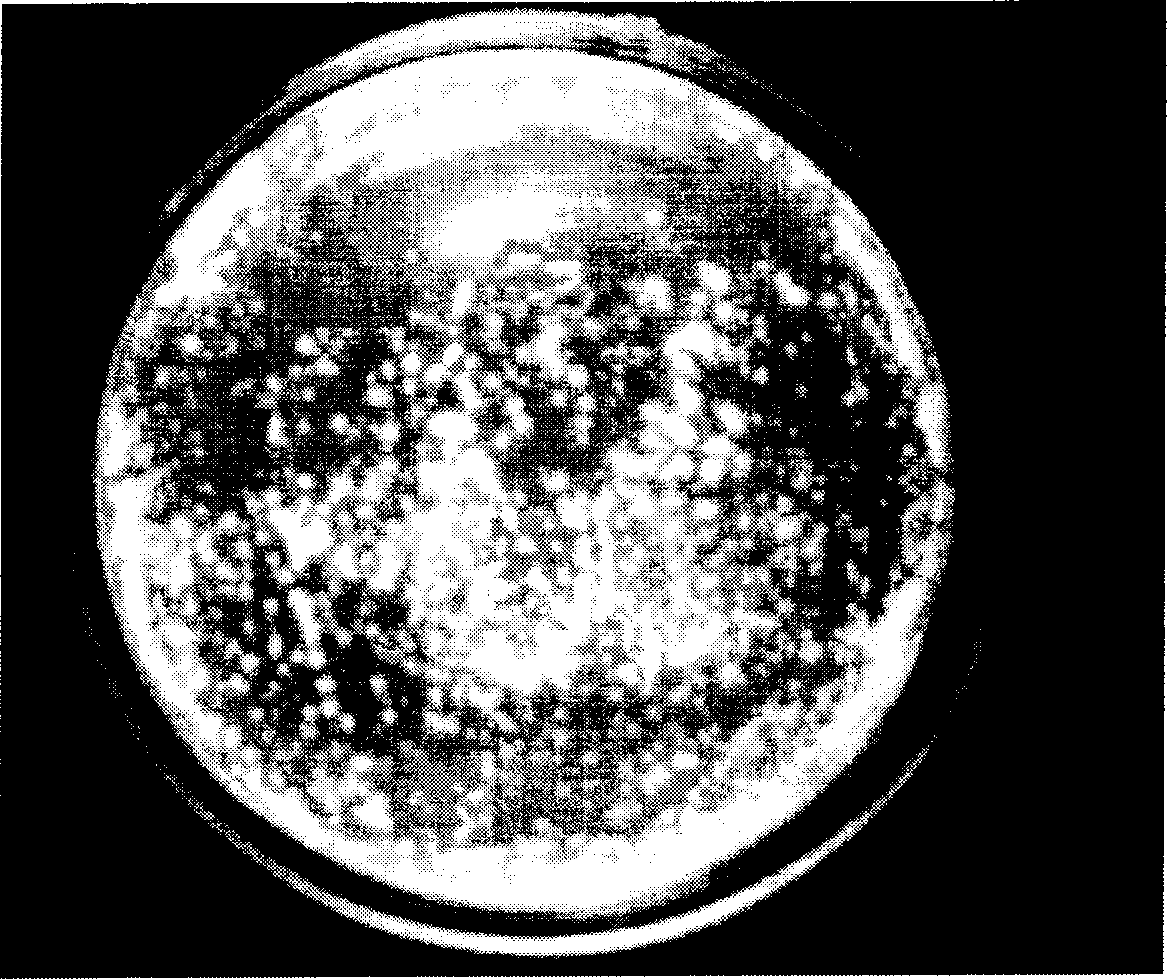Rhodococcus erythropolis for biological desulfurization and its use
A technology of Rhodococcus erythropolis and biological desulfurization, applied in the direction of bacteria, etc., can solve the problems of long growth cycle of strains, shortening the life of biocatalysts, and insufficient catalytic activity of desulfurization strains, and achieve good oil resistance, short growth cycle, and desulfurization highly active effect
- Summary
- Abstract
- Description
- Claims
- Application Information
AI Technical Summary
Problems solved by technology
Method used
Image
Examples
Embodiment 1
[0046] Embodiment 1: the screening of FSD-2 bacterial strain
[0047] Oil-contaminated soil samples were taken from the vicinity of the Gudao Oilfield in Shandong, and a three-step process was used to screen, isolate, and purify microorganisms that selectively desulfurize oil. In the first step, add 0.5 g of oil-contaminated soil sample to 50 ml of sulfur-free basic medium FBM containing a final concentration of 1 mmol / l DBT (FBM medium contains 10.0 g / l glucose, 2.0 g / l NH 4 Cl, 6.3g / l KH 2 PO 4 , 8.0g / l K 2 HPO 4 , 0.2g / lMgCl 2 ·6H 2 O, etc., the FBM medium containing 1mmol / l DBT is FBMD medium), 30 DEG C shaking culture 5 days, transfer to FBMD medium with 10% inoculum size, cultivate 2 days under the same condition, transfer 2 times repeatedly -3 times. In the second step, after such 2-3 enrichment cultures, take 1ml of the culture, centrifuge at 3000rpm for 5min, and take 0.5ml of the supernatant for Gibb's analysis (after DBT is degraded by the "4S" pathway, the g...
Embodiment 2
[0049] Example 2: FSD-2 strain metabolite analysis
[0050] Pick the FSD-2 strain cultured on the FMAD agar slant and inoculate into 50ml FMAD liquid medium. Components of FMAD liquid medium: 5g / l glucose, 2g / l NH 4 Cl, 14.04g / l Na 2 HPO 4 , 2.24g / l KH 2 PO 4 , 0.2g / l MgCl 2 ·6H 2 O, the addition amount of trace element solution mother solution and vitamin solution mother solution is 1.0ml / l respectively, the final concentration of DBT is 1.0mmol / l, and the pH value is 7.0~7.2. Trace element mother liquor contains 0.5g / l FeCl 2 4H 2 O, 0.5g / l ZnCl 2 , 0.5g / l MnCl 2 4H 2 O, 0.1g / l NaMoO 4 2H 2 O, 0.05g / l CuCl 2 , 0.05g / l NaWO 4 2H 2 O and 120mmol / l HCl. Vitamin mother solution contains 400mg / l calcium pantothenate, 200mg / l inositol, 400mg / l niacin, 400mg / l pyridoxine hydrochloride, 200mg / l p-aminotoluene and 0.5mg / l VB12. Culture at 30℃, 150 rpm After 24-48 hours, take 10ml of the culture, add 2ml of dichloromethane to extract the metabolites in the culture, a...
Embodiment 3
[0051] Embodiment 3: FSD-2 bacterial strain growth cell degrades DBT
[0052] Pick the FSD-2 strain cultured on the FMAD agar slant and inoculate into 50ml FMAD liquid medium. Components of FMAD liquid medium: 5g / l glucose, 2g / l NH 4 Cl, 14.04g / l Na 2 HPO 4 , 2.24g / l KH 2 PO 4 , 00.2g / l MgCl 2 ·6H 2 O, the addition amount of trace element solution mother solution and vitamin solution mother solution is 1.0ml / l respectively, the final concentration of DBT is 0.5mmol / l, and the pH value is 7.0~7.2. Trace element mother liquor contains 0.5g / l FeCl 2 4H 2 O, 0.5g / l ZnCl 2 , 0.5g / l MnCl 2 4H 2 O, 0.1g / l NaMoO 4 2H 2 O, 0.05g / l CuCl 2 , 0.05g / l NaWO 4 2H 2 O and 120mmol / l HCl. Vitamin mother solution contains 400mg / l calcium pantothenate, 200mg / l inositol, 400mg / l niacin, 400mg / l pyridoxine hydrochloride, 200mg / l p-aminotoluene and 0.5mg / l VB12. Culture at 30℃, 150rpm , regularly sampled for Gibb's analysis. Gibb's analysis method is as follows: centrifuge the cul...
PUM
 Login to View More
Login to View More Abstract
Description
Claims
Application Information
 Login to View More
Login to View More - R&D
- Intellectual Property
- Life Sciences
- Materials
- Tech Scout
- Unparalleled Data Quality
- Higher Quality Content
- 60% Fewer Hallucinations
Browse by: Latest US Patents, China's latest patents, Technical Efficacy Thesaurus, Application Domain, Technology Topic, Popular Technical Reports.
© 2025 PatSnap. All rights reserved.Legal|Privacy policy|Modern Slavery Act Transparency Statement|Sitemap|About US| Contact US: help@patsnap.com



